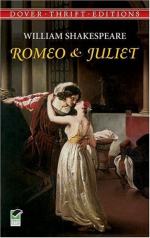|
This section contains 8,184 words (approx. 28 pages at 300 words per page) |

|
SOURCE: Knowles, Ronald. “Carnival and Death in Romeo and Juliet.” In Shakespeare and Carnival: After Bakhtin, edited by Ronald Knowles, pp. 36-60. London: Macmillan, 1998.
In the following excerpt, Knowles applies Mikhail Bakhtin's cultural theory of the carnivalesque to Romeo and Juliet, particularly in regard to the drama's themes of love and death.
As the title Rabelais and His World indicates, Bakhtin is primarily concerned with medieval culture, but he does offer many fascinating asides on the carnivalesque in the early modern world, and in Shakespeare particularly. ‘Shakespeare's drama’, he writes, ‘has many outward carnivalesque aspects: images of the material body lower stratum, of ambivalent obscenities, and of popular banquet scenes.’ He also suggests that ‘the analysis we have applied to Rabelais would also help us to discover the essential carnival element in the organization of Shakespeare's drama. This does not merely concern the secondary clownish motives of his...
|
This section contains 8,184 words (approx. 28 pages at 300 words per page) |

|


